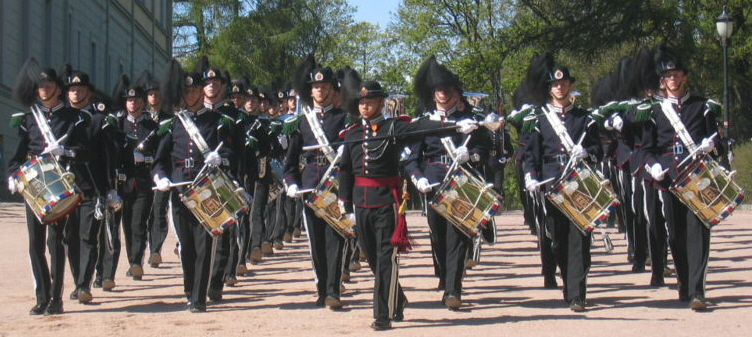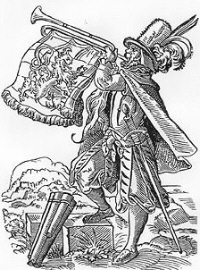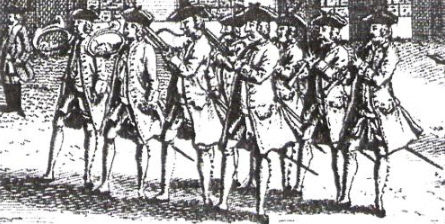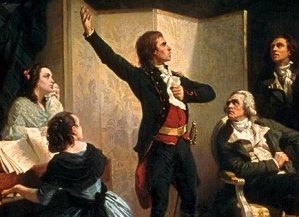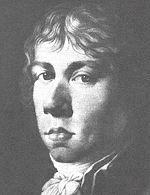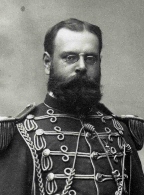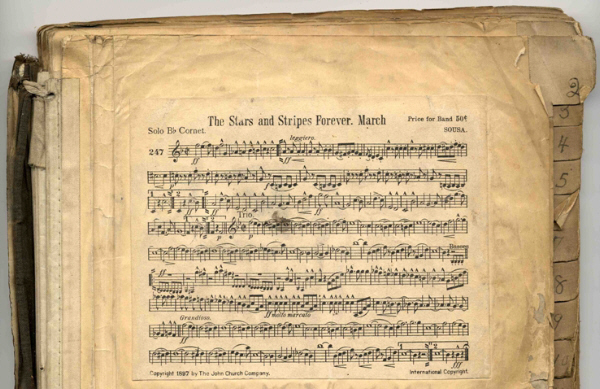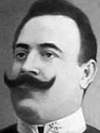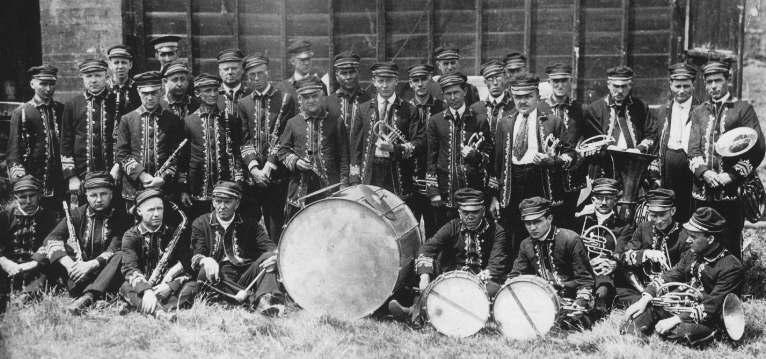10
|
||||||||||||||||||||||||||||||||||||||||||||||||||||||||||||||||||||||||||||||||||||||||||||||||||||||||||||||||
MILITARY USES OF MUSICThe coupling of wind and percussion instruments with the military is a practice dating back thousands of years. Shakespeare expressed it well in a tribute that became the inspiration for Elgar's five Pomp and Circumstance marches, Op. 39:
The legacy of the march as a musical form has long been associated with the military, and rightly so, since its earliest appearance was most assuredly designed to support the military. EARLY MILITARY USEWind instruments and drums were basic to battle long before Shakespeare or Dryden. In the Bible, the Old Testament book of Judges describes an Israelite leader named Gideon who, in the 12th century BC, routed a far superior force of Midianites with three hundred men, each carrying nothing more than a trumpet in one hand and a lighted torch in the other. In the 1st century BC, Virgil described in the Aeneid the sound of instruments building zeal for battle. The Greeks and Romans used the tuba, cornu, and bucina to sound rhythmic calls to convey military information. In the Middle Ages, after coming into contact with the Saracen forces and their musicians during the Crusades, the Europeans began to use wind and percussion instruments as elements of war. In the late 15th century the Swabian and Swiss Landsknechte used side drums for military calls, and Machiavelli referred to the use of trumpets, drums, and flutes in his Libro della arte dell guerra (1521). In addition to stipulating how they should be used for communication in battle, Machiavelli further advised military music as an aid for marching.1 From these simple, even crude origins, the march, with its military foundation, evolved into what would become the most common art form identified with the wind band. - Back to Top -MARCH FORMRichard Franco Goldman described the march as a highly stylized form of dance, much like the waltz or minuet. If so, it certainly employs a most simple step. Yet it is a step which dictates the style of music with which it is coupled. Marches, through centuries of evolution, have gradually taken on a more sophisticated format, but the basic elements of the march remain: 1. Music as an ornamentation of a regular, fixed, or repetitive drum rhythm. Until the 19th century, the simple harmonic and melodic style of the march was attributed at least in part to the technical limitations of wind instruments, especially regarding horns and trumpets, which were still limited to their respective overtone series. MARCH TEMPOHistorically, march tempos were dependent on the function of the occasion. The slow march (Fr. pas ordinaire; Ger. Parademarsch) was used for parades, reviews, and exercises, and its tempo varied from 60 to 80 beats per minute. The quick march (Fr. pas redoublé; Ger. Geschwindmarsch), used for maneuvering, was approximately twice as fast as the slow march with tempos ranging from 100 to 140 beats per minute, 116-120 beats per minute being considered the norm. The double-quick march (Fr. pas de charge; Ger. Sturmmarsch) was even faster, and was used for attack.3 - Back to Top -EARLY MARCHESSome of the earliest surviving marches date from the Baroque, and include compositions by Lully and André Philidor. From examples collected by Philidor in 1705 the repertoire included marches for drums alone, timpani alone, and trumpet alone, along with other examples for Louis XIV's fife and drum band and oboe and drum band. These are written in several time signatures including ¢, 2, 3/2, and 3. Examples of structure range from Philidor's La retraite consisting of two eight measure strains to the less common La générale by Lully written in two strains of seven measures in triple meter. Marches from the 17th and 18th centuries generally are simple, functional pieces, often adapted from popular songs, operas, and oratorios. Adapting popular tunes for marches seems to have been quite prevalent in Britain where printed collections such as Sprightly Companion (1695), Music bellicosa (1733), Musica curiosa (1745), and Warlike Musick (1760) borrowed elements from operas and oratorios from local and foreign composers including Handel, Jommelli, Graun, Traetta, and Monsigny. In France, the Revolution and Napoleonic wars provided a number of composers the opportunity to write patriotic marches for financial gain. These included Gossec, Méhul, Cherubini, and Catel, as well as C. J. Rouget de Lisle. Rouget de Lisle penned what was probably the most famous march of the era--the Marseillaise, first written under the title Chant de guerre pur l'armée du Rhin (Song of war for the Army of the Rhine). In Britain, troops also marched to music composed by native-born composers including Thomas Busby, Hohm Callcott, William Crotch, James Hook, John Mahon, and Alexander Reinagle, as well as foreigners with English ties such as Handel and Haydn. Haydn's marches (H. VIII: 1-4 and 6-7) are scored for pairs of clarinets, bassoons and horns, with trumpet, serpent and improvised percussion parts. Only one has a trio, and all are barely thirty measures in length. The form is usually two strains, which begin with an upbeat and consist of dotted eighth rhythms.4 Austrian regiments marched to compositions written by F. X. Süssmayr, Ferdinando Paer, Hummel and Beethoven. Beethoven wrote a number of pieces for military band, including a polonaise, an écossaise and several tattoos, as well as pieces titled marsch or marcia. Some of the pieces feature the Jannisary percussion. Beethoven's marches typically were written in a homophonic style with phrases of two to four measures in length, often emphasizing repeated notes and double-dotted figures. Two (WoO20 and 24) were scored with trios in contrasting keys--a custom which would become accepted practice for military marches well into the twentieth century.5 - Back to Top -THE GOLDEN ERA OF THE MARCHThe Stars and Stripes ForeverJohn Philip Sousa was on a tour of Europe with his wife in 1896 when he received a cable from New York informing him of the death of the Sousa Band's tour manager, David Blakely. Feeling compelled to return to New York as soon as possible, Sousa and his wife set sail from Naples, Italy for America in quick fashion. In his autobiography Marching Along, Sousa explained what happened next:Here came one of the most vivid incidents of my career. As the vessel steamed out of the harbor I was pacing the deck, absorbed in thoughts of my manager's death and the many duties and decisions which awaited me in New York. Suddenly, I began to sense the rhythmic beat of a band playing within my brain. It kept on ceaselessly,playing, playing, playing. Throughout the whole tense voyage, that imaginary band continued to unfold the same themes, echoing and re-echoing the most distinct melody. I did not transfer a note of that music to paper while I was on the steamer, but when we reached shore, I set down the measures that my brain-band had been playing for me, and not a note of it has ever been changed.1 The composition Sousa referred to was none other than The Stars and Stripes Forever. This signature march eventually became the official march of the United States, as well as one of the most familiar pieces known throughout the world. The 19th century ushered in the glory days of the march. As bands grew in size and popularity, civic and professional bands often wore two hats, so to speak, fulfilling military obligations in addition to providing music for civic occasions. To this end, band performances interspersed marches with waltzes, quadrilles, galops, polkas, or whatever the popular trend was at the time. As a result, marches no longer served a marching or military purpose exclusively, but were penned to celebrate occasions that might be military and/or civic in nature, or to commemorate regiments, generals, rulers, or specific battles. A number of these have survived in the repertoire of concert bands and light orchestras. Among these are the march Washington Grays by Claudio Grafulla, and the Radetsky March by Johann Strauss, Sr.--possibly his best known composition. The popularity of certain marches is occasionally linked to the composer, such as Beethoven's Yorck'scher Marsch, or any number of marches penned by Kenneth J. Alford or John Philip Sousa. A march may also be found in a section of a much larger work. Being incorporated into Berlioz' Damnation of Faust, and Liszt's Hungarian Rhapsody no. 15, has provided the Rákóoacute;czi March with exposure it would not have enjoyed otherwise. Marches written between the years after the American Civil War and World War I provide the bulk of the music considered the core of the repertoire. The typical form of these marches begins with an introduction or fanfare, followed by first and second strains that repeat. The repetition of the first strain, or the entire second strain, sometimes contains a featured melody in the low winds. A trio section follows, usually in a neighboring key, with the melody played in a legato style. A repetition of the trio customarily concludes the march, unless there is a closing strain replete with aggressive and/or grandiose playing (sometimes referred to as the dogfight). This structure, coupled with contrasting styles from marcato to legato, and dynamics from pp to ff, has made the march an enjoyable medium for audiences for many decades. Representative examples of these marches include:
Perhaps the most notable march composers during these years were the American John Philip Sousa and the British composer Kenneth J. Alford, whose marches are still considered among the most memorable ever penned. - Back to Top -TWENTIETH-CENTURY MARCHESZo ElliotZo Elliot is most remembered for two works with strong British ties. Lloyd George, then Prime Minister of England referred to his tune "There's a Long, Long Trail" as "the song that helped us win the war [World War I]." His march, British Eighth, was written as a tribute to General Bernard Montgomery and the Eighth Army after their triumphant sweep across Northern Africa in 1942 in the middle of World War II. British Eighth is one of the most performed marches on both sides of the Atlantic. But the rest of the story lies in the fact that Elliot, despite his British-sounding name, was in fact an American who hailed from New Hampshire.2Movies and TelevisionIn the middle of the 20th century marches entered the band repertoire through television and movie scores, such as Guadalcanal (from the movie Victory at Sea) by Richard Rogers, and Dambusters by Eric Coates. Circus MarchesA number of familiar marches were written for circus bands. They were written with the purpose of enhancing the atmosphere for performers and audience alike. Entry of the Gladiators by Julius Fucik, In Storm and Sunshine by John C. Heed, Henry Fillmore's Rolling Thunder and The Circus Bee, and Karl L.King's Robinson's Grand Entree are just a few examples of circus marches whose performance was vital in entertaining audiences across the United States during the golden years of the traveling circus. - Back to Top -MARCHES IN A VARIETY OF GENRESSymphony/Symphonic FormIn addition to the functional format discussed above, the march has also been a factor in art music. It has been used in symphonic form to fulfill a variety of purposes. Berlioz used it as an aid to storytelling in the fourth movement of his Symphonie Fantastique. A certain amount of humor is projected in Mahler's 2nd Symphony where the children's song "Frère Jacques" is heard in a minor key parodying a funeral march. The Turkish march in the middle of the last movement of Beethoven's 9th Symphony is perhaps the most famous march in a symphony. Marches have also played a key role in coronation music throughout the centuries; in the 20th century Walton's Crown Imperial and Orb and Scepter are but two examples.
- Back to Top -Ballet and Incidental MusicMarches also have been common in ballet and incidental music:
Marches in OperaOpera composers have written marches to aid in depicting a variety of situations, including processionals and military connotations.
- Back to Top -Keyboard MarchesKeyboard music from the Elizabethan age to the 20th century has allowed composers to depict a story or simply provide a simple, straightforward medium for expression.
CONCLUSIONDespite its humble roots, the march has stirred the imagination of a variety of composers over hundreds of years. Perhaps its most fundamental popularity with performers and audiences alike resides in its simple beat--an element as commonplace as the beat of one's own heart. - Back to Top -
|
||||||||||||||||||||||||||||||||||||||||||||||||||||||||||||||||||||||||||||||||||||||||||||||||||||||||||||||||
